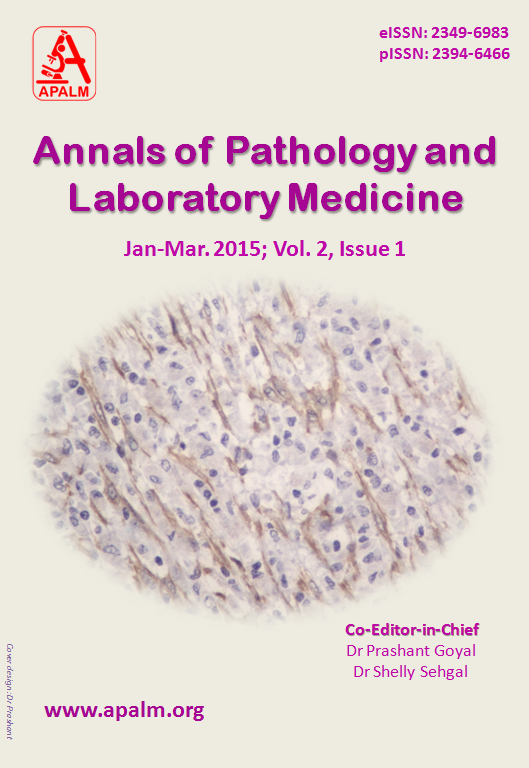Primary pure large cell neuroendocrine carcinoma of ovary: An extremely rare entity
Keywords:
Immunohistochemistry, Neuroendocrine Carcinoma, Ovary, PrimaryAbstract
Primary large cell neuroendocrine carcinoma of ovary is an uncommon neoplasm with an aggressive biological behaviour. These carcinomas usually occur in association with epithelial-sex cord tumours; pure form being a rarity which can pose a diagnostic difficulty. A 42 year old female presented with a large abdominal mass and pain. Computed tomography revealed a heterogeneously enhancing solid left ovarian mass. Differential diagnoses on histopathology included large cell neuroendocrine carcinoma, carcinoid tumour, hepatoid carcinoma and malignant steroid cell tumour, not otherwise specified (NOS). Positive neuroendocrine markers including CD56, chromogranin, and NSE facilitated a correct diagnosis of large cell neuroendocrine carcinoma. Primary ovarian large cell neuroendocrine carcinomas are under-recognized aggressive tumours and must be considered as a differential in undifferentiated ovarian tumours. Histologic features and a panel of immunohistochemical stains should lead to the correct diagnosis.
References
2. Tavassoli FA, Devilee P. World Health Organiza-tion classification of tumours. Pathology and ge-netics of tumours of the breast and female genital organs. IARC Press, Lyon, 2003.
3. OshitaT, Yamazaki T, Akimoto Y, Tanimoto H, Nagai N, Mitao M et al.Clinical features of ovar-ian large-cell neuroendocrine carcinoma: Four case reports and review of the literature. Exp Ther Med 2011; 2: 1083-90.
4. Dundr P, Fischerová D, Povýsil C, Cibula D. Primary pure large-cell neuroendocrine carci-noma of the ovary. Pathol Res Pract 2008; 204: 133-7.
5. Behnam K, Kabus D, Behnam M. Primary ovar-ian undifferentiated non-small cellcarcinoma, neuroendocrine type. Gynecol Oncol 2004; 92: 372—5.
6. Lindboe CF. Large cell neuroendocrine carci-noma of the ovary. APMIS 2007; 115: 169-176.
7. Eichhorn JH, Lawrence WD, Young RH, Scully RH. Ovarian neuro¬endocrine carcinomas of non-small-cell type associated with surface epi-thelial adenocarcinomas. A study of five cases and review of the literature. Int J Gynecol Pathol 1996; 15: 303-314.
8. Young RH, Oliva E, Scully RE. Small cell carci-noma of the ovary, hypercalcemic type. Am J SurgPathol 1994;18:1102—16.
Downloads
Published
Issue
Section
License
Copyright (c) 2015 Poonam Bhaker, Pranab Dey, Radhika Srinivasan, Subhash Chandra Saha

This work is licensed under a Creative Commons Attribution 4.0 International License.
Authors who publish with this journal agree to the following terms:
- Authors retain copyright and grant the journal right of first publication with the work simultaneously licensed under a Creative Commons Attribution License that allows others to share the work with an acknowledgement of the work's authorship and initial publication in this journal.
- Authors are able to enter into separate, additional contractual arrangements for the non-exclusive distribution of the journal's published version of the work (e.g., post it to an institutional repository or publish it in a book), with an acknowledgement of its initial publication in this journal.
- Authors are permitted and encouraged to post their work online (e.g., in institutional repositories or on their website) prior to and during the submission process, as it can lead to productive exchanges, as well as earlier and greater citation of published work (See The Effect of Open Access at http://opcit.eprints.org/oacitation-biblio.html).






